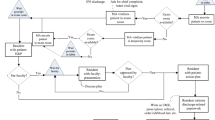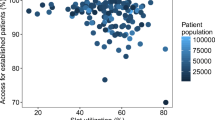Abstract
Many outpatient clinics are experimenting with open access scheduling. Under open access, patients see their physicians within a day or two of making their appointment request, and long term patient booking is very limited. The hope is that these short appointment lead times will improve patient access and reduce uncertainty in clinic operations by reducing patient no-shows. Practice shows that successful implementation can be strongly influenced by clinic characteristics, indicating that open access policies must be designed to account for local clinical conditions. The effects of four variables on clinic performance are examined: (1) the fraction of patients being served on open access, (2) the scheduling horizon for patients on longer term appointment scheduling, (3) provider care groups, and (4) overbooking. Discrete event simulation, designed experimentation, and data drawn from an intercity clinic in central Indiana are used to study the effects of these variables on clinic throughput and patient continuity of care. Results show that, if correctly configured, open access can lead to significant improvements in clinic throughput with little sacrifice in continuity of care.
Similar content being viewed by others
References
Babes M, Sarma G (1991) Out-patient queues at the Ibn-Rochd health centre. J Oper Res Soc 42(10):845–855
Bean AG, Talaga J (1995) Predicting appointment breaking. J Health Care Mark 15(1):29–34
Brahimi M, Worthington DJ (1991) Queueing models for out-patient appointment systems—a case study. J Oper Res Soc 42(9):733–746
Cayirli T, Veral E (2003) Outpatient scheduling in health care: a review of literature. Prod Oper Manag 12(4):519–549
Cayirli T, Veral E, Rosen H (2006) Designing appointment scheduling systems for ambulatory care services. Health Care Manage Sci 9:47–58
DeLaurentis P, Kopach R, Rardin R, Lawley M, Muthuraman K, Wan H, Ozsen L, Intrevado P (2006) Open access appointment scheduling—an experience at a community clinic. Proceedings of 2006 IIE annual conference and exposition, Orlando, FL
Dervin JV, Stone DL, Beck CH (1978) The no-show patient in the model family practice unit. J Fam Pract 7(6):1177–1180
Deyo RA, Inui TS (1980) Dropouts and broken appointments. Med Care 18(11):1146–1157
George A, Rubin G (2003) Non-attendance in general practice: a systematic review and its implications for access to primary health care. Fam Pract 20:178–184
Giachetti R, Centeno EA, Centeno MA, Sundaram S (2005) Assessing the viability of an open access policy in an outpatient clinic: a discrete-event and continuous simulation modeling approach. Proceedings of the 2005 winter simulation conference, pp 2246–2255
Goldman L, Freidin R, Cook F, Grich P (1982) A multivariate approach to the prediction of no-show behavior in a primary care center. Arch Intern Med 142:563–567
Grumbach K, Bodenheimer T (2002) A primary care home for Americans: putting the house in order. JAMA 288(7):889–893
Harper P, Gamlin H (2003) Reduced outpatient waiting times with improved appointment scheduling: a simulation modeling approach. OR Spectrum 25:207–222
Ho C-J, Lau H-S (1992) Minimizing total cost in scheduling outpatient appointments. Manage Sci 38(12):1750–1764
Jun JB, Jacobson SH, Swisher JR (1999) Application of discrete-event simulation in health care clinics: a survey. J Oper Res Soc 50(2):109–123
Kennedy J, Hsu J (2003) Implementation of an open access scheduling system in a residency training program. Fam Med 35(9):666–670
Klassen KJ, Rohleder TR (2004) Outpatient appointment scheduling with urgent clients in a dynamic multi-period environment. Int J Serv Ind Manag 15(2):167–186
Koizumi N, Kuno E, Smith TE (2005) Modeling patient flows using a queuing network with blocking. Health Care Manage Sci 8(1):49–60
Lee VJ, Earnest A, Chen MI, Krishnan B (2005) Predictors of failed attendances in a multi-specialty outpatient centre using electronic databases. BMC Health Serv Res 5:51
Mondschein S, Weintraub G (2003) Appointment policies in service operations: a critical analysis of the economic framework. Prod Oper Manag 12(2):266–286
Murdock A, Rodgers C, Lindsay H, Than TCK (2002) Why do patient not keep their appointments? Prospective study in a gastroenterology outpatient clinic. J R Soc Med 95:284–286
Murray M, Berwick DM (2003) Advanced access: reducing waiting and delays in primary care. JAMA 289(8):1035–1040
Muthuraman K, Lawley M (2006) A stochastic overbooking model for outpatient clinical scheduling with no-shows. (in revision)
Qu X, Rardin RL, Williams JAS, Tieman L, Wan H, Willis DR, Rosenman MB A statistical model for the prediction of patient non-attendance in a primary care clinic. Proceedings of 2006 IIE annual conference and exposition, Orlando, FL
Robinson L, Chen R (2003) Scheduling doctors’ appointments: optimal and empirically based heuristic policies. IIE Trans 35(3):295–307
Rothstein M (1985) OR and the overbooking problem. Oper Res 33(2):237–248
Schers H, van den Hoogen H, Bor H, Grol R, van den Bosch W (2004) Preference for a general practitioner and patients’ evaluations of care: a cross-sectional study. Br J Gen Pract 54(506):693–694
Stokes T, Tarrant C, Mainous A, Schers H, Freeman G, Baker R (2005) Continuity of care: is the personal doctor still important? A survey of general practitioners and family physicians in England and Wales, the United States, and The Netherlands. Annals of Family Medicine 3(4):353–359
Vanden Bosch PM, Dietz DC (2000) Minimizing expected waiting in a medical appointment system. IIE Trans 32(9):841–848
Author information
Authors and Affiliations
Corresponding author
Rights and permissions
About this article
Cite this article
Kopach, R., DeLaurentis, PC., Lawley, M. et al. Effects of clinical characteristics on successful open access scheduling. Health Care Manage Sci 10, 111–124 (2007). https://doi.org/10.1007/s10729-007-9008-9
Received:
Accepted:
Published:
Issue Date:
DOI: https://doi.org/10.1007/s10729-007-9008-9




